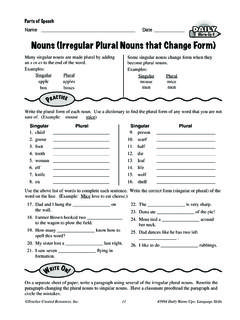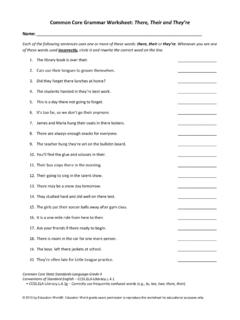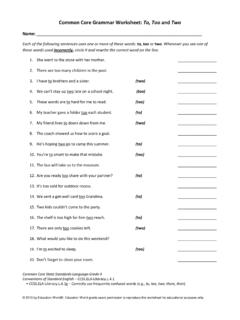Transcription of Education World ® 2005 | EducationWorld.com …
1 Education World 2005 | Create a Seating Chart with Excel By Lorrie Jackson WHY A TECHTORIAL? What will I learn today? You will learn how to create a seating chart using Microsoft Excel. What hardware and/or software does the techtorial apply to? The techtorial applies to most newer versions of Excel (PC or Mac). Which National Educational Technology Standards for Teachers does the techtorial address? The techtorial will help teachers accomplish standard NETS in particular. The International Society for Technology in Education (ISTE) has developed a set of National Educational Technology Standards for Teachers.
2 Standards or Performance Indicators are included for each techtorial to help teachers and administrators improve technology proficiency. For a complete description of the standards indicated, go to NETS for Teachers. CREATE A CLASSROOM SEATING CHART From targeting students with specific behavior issues to enabling substitute teachers to quickly identify students, seating charts can be a great help in the K-12 classroom. They also can be an annoyance to keep neat and up to date, however. So how do you make a chart that's easy to read and easy to edit as classroom furniture and students change? Consider using Microsoft Excel.
3 In addition to its role as a spreadsheet program, Excel excels as a basic drawing program, allowing even beginning users a chance to create professional looking work in just a few simple steps. STEP ONE: THE BASIC LAYOUT First, you need to create the basic layout. Open Excel. Click View>Page Layout to make sure you can see where your page ends. Note: Although it would be easier to see the entire page if you changed the page orientation to Landscape, that would make labeling with the Text box tool difficult, so keep the portrait orientation. Click View>Header and Footer>Customize Header. Click in the Center Section and type your name or the name of your class.
4 You can add additional information in the left, center, or right sections, but don't exceed two lines or you'll run into the chart. Click OK twice. Make sure you can see the entire first page of the spreadsheet at once. (Although you won't see the title until you print the chart or click File>Print Preview.) You might need to reduce the zoom (View>Zoom) until you can see the whole page. Save your work. STEP TWO: THE ROOM Next, create the room and the furniture. Click View>Toolbars>Drawing. On the Drawing toolbar, click the Rectangle icon. Draw a basic rectangle on the spreadsheet. As you draw, keep in mind the basic dimensions or shape of the room (square?)
5 Long and skinny?). Click the Paint Can on the Drawing toolbar and select No Fill. That will allow you to see the cell gridlines in the background again. The gridlines won't print with the chart, but they serve as a helpful guide when drawing furniture. On some room charts, doorways are indicated by a straight line angled into the room, and windows by a short line parallel to the wall. To add windows and doors, click the line tool on the Drawing Toolbar. Draw a line anywhere on the spreadsheet, and then drag the line to the right place on the chart. Click and hold an end of a line to angle it, or to shorten or lengthen it.
6 To change the width of any of the lines, click the Line Style icon STEP TWO CONTINUED: THE FURNITURE To create desks and other furniture, use the Autoshapes drawing tool. Draw outlines of the furniture, and then move each piece to its correct location on the chart. (Don't forget, you can click an object you've drawn and then click CTRL D (or Command D on a Mac) to make a duplicate of that object.) Be sure to include as furniture such items as a podium, projector, bookcase, chair and so on -- any items that take up space should be on the chart. After you've made all the student desks, you might want to straighten the rows a bit.
7 To do that: Hold down the Shift key and click each desk to select it. When all the desks are selected, click the first icon on the Drawing toolbar. Click Align/Distribute, and select either Align Middle or Distribute Horizontally (or another choice)! Finally, you can format the size of the furniture to correct the dimensions of the room: Double-click any piece of furniture to open the Format Object window and then type in a precise size for that object. To make things easier to calculate, you might want to consider reducing the size of items on the chart to a 100th of the size of the actual piece of furniture.
8 (A desk measuring 37 inches wide would be .37 of an inch on the schematic, for example.) Don't forget to save your work. Your seating chart might look something like this: STEP THREE: ADDING NAMES Of course, a seating chart isn't useful unless the desks are labeled. To add a name to each desk Click View>Zoom, change the viewing size to 75 percent, and then click OK. On the Drawing toolbar, click the black "A" that looks like a typewriter font. Click a desk on the chart, and type the name of the student who sits at that desk. Click outside the desk. Notice that the program wrapped the name back to the left margin.
9 After you've typed one name -- and before you go on to the next name -- click File>Print Preview to make sure you can read the name. Change font size, color, and/or style as necessary for readability. The font should be as large as possible while still fitting every student's name in his or her "desk" area. (You might want to label the desk of the student with the longest name first!) Save your work. SAVING AND REUSING YOUR SEATING CHART Up until now, you've been saving your spreadsheet as a normal Excel file. Now, you'll save the seating chart as a template, so you can use the basic furniture layout either for other classes or in future years.
10 A template is a file that always stays the same. If you open it and change it, you can save the changes only in a new file. That keeps the original file safe from changes -- accidental or intentional! To save the file as a template: -Click File>Save As. Add the word "template" to the seating chart's file name. -For Format (or File Type) select Template. -Decide where to save your seating chart template. Excel wants to save it in a template folder where you'll probably never find it (!), so be sure to choose where you want your template to be saved -- in My Documents, perhaps, or in the folder where you've been saving the seating chart thus far.












